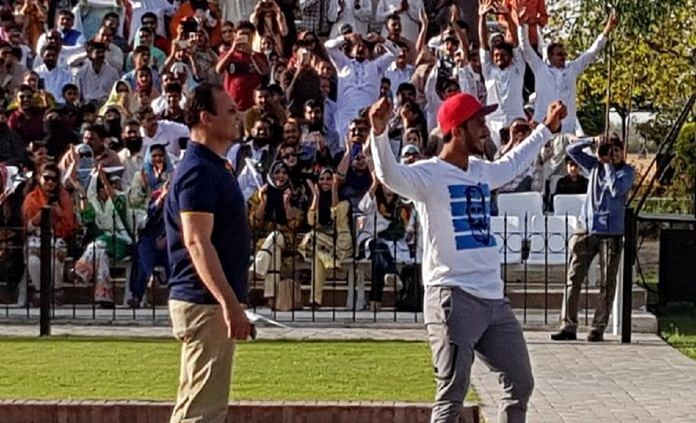Introduced in 1959, the 45-minute flag-lowering ceremony at the Attari-Wagah border was a low-key affair for decades but now draws hundreds of visitors daily.
Chandigarh: Pakistan cricketer Hasan Ali’s provocative gestures this weekend at the Attari-Wagah border have once again thrown the spotlight on the ‘flag-lowering’ ceremony, which started as a dignified show of military traditions and patriotism.
Introduced in 1959, the 45-minute ritual was a low-key affair for decades but now draws hundreds of visitors daily. It revolves around the lowering of the flags, at sunset, on both sides of the international border. It is conducted by the jawans of the Border Security Force (BSF) and the Pakistan Rangers.
It was discontinued during the 1965 and 1971 wars, but went on through Kargil in 1999. In fact, it was after the Kargil war that the ceremony was said to have transformed into a show of physical strength marked by aggressive gesturing by soldiers.
Over the years, some efforts have been made to “tone down” the ceremony but neither side is ready to give up the display, considered a matter of pride for the soldiers.
On Saturday, the Pakistani side allowed Ali, a civilian, to come near the gates, where, facing Indian spectators, he tapped his thigh and jeered, apart from making other indecorous gestures. The BSF subsequently lodged a protest with the Pakistan Rangers about the incident.
The massive audiences seem to have encouraged both sides to almost view it as entertainment. Last year, a song-and-dance performance by uniformed BSF personnel on Independence Day drew sharp criticism on social media.
The ceremony
For the ceremony, amphitheatre-like seating arrangements have been made on both sides. Before the actual ceremony begins, patriotic music and songs are played on either side of the border. On the Indian side, visitors are allowed to dance in the parade area, and young school students are handed the Tricolour and encouraged to run to the gates.
Indian visitors typically outnumber the attendance on the Pakistani side. Consequently, as slogan-shouting contests ensue between spectators on the two sides, the chants of “Bharat mata ki jai” generally drown out those of “Pakistan Zindabad”.
When the ceremony actually begins, uniformed men take over and a dramatic show of strength begins. This was described by British showman Michael Palin as “carefully choreographed contempt” as he filmed the ceremony for BBC in 2007.
Soldiers on both sides subsequently walk towards each other in exaggerated goose steps, raising one leg well into the air before bringing it down with full force. A hand-shake follows.
‘Tone it down’
In 2006, the commanders on both sides decided that the ceremony didn’t need provocative posturing and gesturing. In 2010, a decision was taken to temper the aggression and include a hand-shake. According to some reports, the move was agreed upon after soldiers sustained foot and knee injuries due to the forceful stomping. However, Pakistan subsequently refused to do so.
In 2014, jawans participating in the parade were provided with special shoes to minimise the impact of the stomping on their knees and back.
A reflection of ties
The ceremony has come to reflect the ebb and flow in bilateral ties. As a goodwill gesture, on Independence Day, Diwali and Eid, soldiers on both sides exchange sweets. But when relations are strained, this exchange is often called off. Following India’s surgical strike across the LoC in 2016, the crowd on the Pakistan side threw stones towards the Indian side before the beginning of the flag-lowering ceremony.
Whose flag is taller
Last year, the border became the playground for a new form of competitive nationalism.
In March, the Amritsar Improvement Trust hoisted a 120-foot-long and 80-foot-broad Tricolour on a 360-foot-tall pole at Attari, which was then hailed as India’s tallest flag. However, strong winds at that height kept tearing the flag and it had to be brought down several times, replaced and hoisted again.
On their independence day in August, Pakistan kicked off celebrations by hoisting a 400-foot-high flag at the border. The size of their flag is the same as India’s, but it is on a taller pole, making it the highest flag in south Asia.






